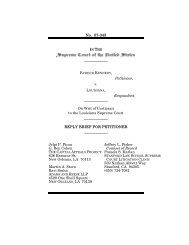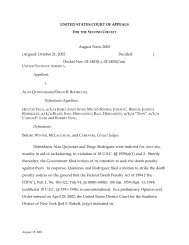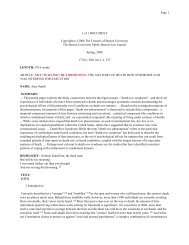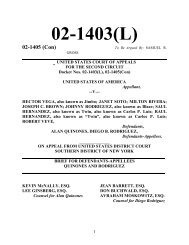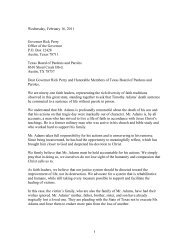ForewordKelsey Patterson spent much ofthe 1980s in and out of mental hospitalsin Texas. No one questionedthat he had a severe mental illness –paranoid schizophrenia – that oftencaused him to become violent.In 1980, he shot and seriouslywounded a co-worker. Patterson believedhis food was being poisoned bythe man even though they’d only metthat morning. Three years later, Pattersonwounded another man duringa delusional assault. In 1986, Pattersonassaulted yet a third victim. Finally,on September 25, 1992, justdays after his brother had tried unsuccessfullyto get him committed toa psychiatric facility, Patterson fatallyshot a businessman and his secretary.He then put his gun down, strippedto his socks, and paced, shouting incomprehensiblyuntil the police arrived.There was no doubt that Pattersonhad committed two murders. Ajudge also ruled that Patterson metthe razor-thin criteria that the U.S.Supreme Court has established to decidewhen someone can be heldlegally accountable <strong>for</strong> their actionseven though they have a mental disorder.Psychiatrists said Pattersonknew he had done something wrongat the time of the killings.In a rare move – only the secondtime in its history - the Texas Boardof Pardon and Paroles sent a recommendationto the governor askingthat Patterson’s life be spared. By a 5to 1 vote, the panel said Patterson deservedmercy because he was simplytoo sick to be punished.The governor ignored that recommendationand on May 18, 2004, aclearly delusional Patterson, stillrambling incoherently, was put todeath.How could a civilized society executesomeone who was so obviouslypsychotic? Was society culpable inthe murders because it permittedKelsey Patterson’s mental state to deterioratedespite nearly a decade ofwarning signs? Would sparing hislife have been fair to the families ofhis two victims? Where should theline be drawn between mental acuityand responsibility <strong>for</strong> criminal acts?Should someone who is in the midstof a psychotic breakdown be treateddifferently from a person with mentalretardation – a class of individualswhom the Supreme Court hasexempted from execution because oftheir obvious diminished culpability?As the father of a son with a severemental illness, the Pattersoncase outraged me.This was a preventable tragedy.In the past two years, I have visited43 states speaking about theneed to re<strong>for</strong>m our mental health system.I’ve toured nearly a hundredmental health treatment programsand my travels have convinced methat we know how to help most peoplewho have mental illnesses. This isnot a case of us being ignorant.Housing First programs, whenteamed with Assertive Community
Treatment teams, have proven successfulin helping even the mostchronically mentally ill persons, certainlythose as sick as Kelsey Patterson.Innovative job programs, such asNew York’s Fountain House, havegiven persons with mental illnessesopportunities to recover. Medications,cognitive behavioral training,peer-to-peer counseling, clubhouses,drop-in centers, outpatient treatment– the list of recovery tools atour disposal is extensive.And yet, at least 100 personsknown to have been severely mentallyill have been executed in ourcountry and another couple of hundredare currently awaiting execution.Meanwhile, more than 300,000persons with severe mental illnessesare currently being warehoused inU.S. jails and prisons. Another halfmillion languish on probation and thelargest public mental facility inAmerica is not a hospital but the LosAngeles jail.This is shameful.I am outraged that the U.S.Supreme Court has adopted such asimplistic <strong>for</strong>mula <strong>for</strong> punishing personswith brain disorders that areanything but simple.I am outraged that states haveadopted involuntary commitmentstandards that focus exclusively onimminent danger and do not considerother signs of deterioration thatclearly signal that a person, such asKelsey Patterson, needs help.I am outraged that even thoughwe spend billions of dollars per yearon mental health care in this countrywe still have a system that, accordingto the President’s New FreedomCommission, is in “disarray.”I am outraged that the publicdoes not understand that mental illnesses,such as schizophrenia, bipolardisorder, and major and persistentdepression, are, in fact, illnesses thatcan strike anyone.I am outraged that families trydesperately to get help <strong>for</strong> their lovedones with mental illness, and insteadinnocent people end up getting murderedby persons who could andshould have been helped.And I am outraged that statesare willing to put money and ef<strong>for</strong>tinto medicating someone so theycompetent enough to be executed,but not willing to put money intomedication earlier, when they couldhelp the person become well andavoid a senseless murder.Thankfully, the National Allianceon Mental Illness and Murder Victims’<strong>Families</strong> <strong>for</strong> <strong>Human</strong> <strong>Rights</strong>have chosen through this report toraise difficult questions that need tobe asked about the death penalty andmental illness. By discussing thesequestions, the two groups open thedoor to an even larger issue: how canwe correct our flawed system?What makes the union of NAMIand MVFHR powerful is that itbrings together advocates <strong>for</strong> personswith mental illnesses and advocates<strong>for</strong> families of murder victims. Thisunion gives both groups’ statementscredibility and power. I greatly admirethe people quoted here becausemany of them are victims, yet ratherthan demanding revenge, they seethe need <strong>for</strong> mental health re<strong>for</strong>m.I hope that NAMI and MVFHRcan help us turn our outrage intoconstructive dialogue and politicalaction that can bring about changes,which will stop lives from being lost– both on our streets and in executionchambers.— Pete Earley, author ofCRAZY: A Father’s Search ThroughAmerica’s Mental Health Madness




